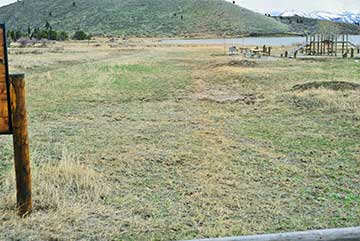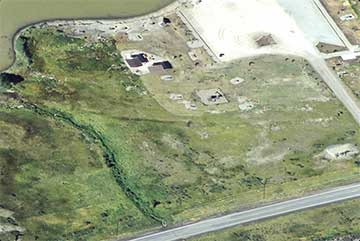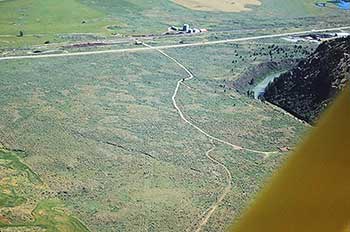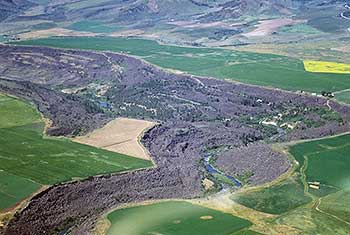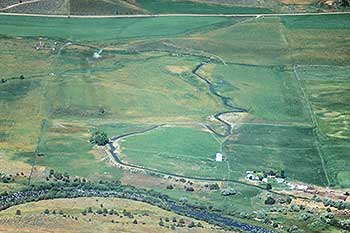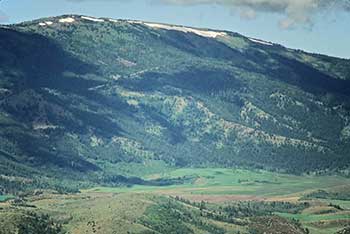| 24-25 | 26 | Aug 27 - Sep 4 | 5 | 6 | 7-8 | 9 | 10 | 11 | 12 | 13 | 14 | 15 | All Photos |
August 11, 1841
Travel west on US 30. At 1.2 miles are two historical signs on the left that explain about Soda Springs and Colonel Patrick Edward Connor. Continue west to OREGON TRAIL STATE PARK (2.7 miles).
Optional tour to Oregon Trail State Park. Enter Oregon Trail State Park and note the trail ruts on the right and left of the road.
Optional tour to the Bear River overlook. Turn left onto the road by the Idaho highway maintenance station. Travel south 0.5 miles to a concrete dam on the Bear River. Note the channel depth of the Bear River as it flows west and then south. Return to US 30.
The Bear River heads in Utah's Summit County in the Uinta Mountains, flows through Wyoming's Unita County, Idaho's Bear Lake, Caribou and Franklin counties, and Utah's Cache and Box Elder counties along a meandering 350-mile course to empty into Great Salt Lake at Bear River Migratory Bird Refuge, 90 miles from its source. The Bear River is the largest river located entirely inside the Great Basin, its flow being exceeded only by the Green and Colorado rivers. At intervals along its course, dams impound and divert the waters for industrial and agricultural purposes.
Michael Bourdon, a twenty-one-year-old French Canadian fur trapper of the Hudson's Bay Company, is given credit for naming the Bear River in 1818 while trapping in the area. He was killed by Indians there the following year. The Indians had names for the river--"Quee-yah-pah" for Tobacco Root Water, and "Gull-yah-pah" for Tobacco Water. These names refer to the color of the river in its lower reaches. The name Michael Bourdon gave refers to the numerous black, brown, and grizzly bears found in the region at that time.
Continue west to the JUNCTION (1.0 miles) with a gravel road on the left.
First Overland Emigrant Party
"Having traveled about 6 miles this morning the Company came to a halt- the Oregon Company were now going to leave Bear river for Ft. Hall, ... here concluded to go into Oregon so that the California company now consisted of only 32 men and one woman and child, there being but one family. The two companies, after bidding each other a parting farewell, started and were soon out of sight."
John Bidwell, August 11, 1841
2002 Utah Westerners Foundation & Utah Crossroads Chapter OCTA BB ID - 1
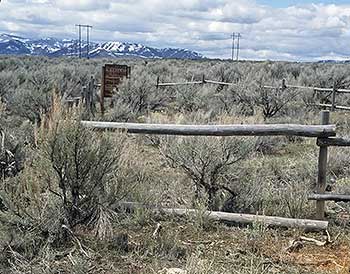 |
| This was said to be a emigrant cemetery but has not been proven. |
Continue west to the JUNCTION (0.9 miles) with SR 34. Optional tour to Oregon Trail ruts. Turn right onto old US 30. At 0.2 miles turn right, and continue east 0.5 miles to the mounds of dirt that block the road. On the left a fence ends. Park and walk past this fence about three hundred feet to view the Oregon Trail ruts in the sagebrush near the railroad fence. This is west of the location where the Bidwell-Bartleson party and the De Smet party separated, the Bidwell-Bartleson party going south and the De Smet party going northwest. John Bidwell described this separation:
Travel west on Center Street. At 1.5 miles cross the Black Canyon of the Bear, where the Bear River has cut a deep channel through the black volcanic rock. This channel becomes deeper downstream as the Bear River cuts through the end of the volcanic rock and flows into the valley.
Continue west to the JUNCTION (3.0 miles) with the Hegstrom road. Turn left onto the Hegstrom road, continue to a bend in the road, then turn right and continue to the JUNCTION (2.0 miles) with Gentile Valley road.
Travel south on Gentile Valley road to the JUNCTION (1.9 miles) with Ralph Hanson road.
Optional tour to 11 August campsite. Travel east then south on Ralph Hanson Road, and at 0.9 miles stop on top of a hill, about four hundred feet from a house at the end of the lane. This is the 11 AUGUST CAMPSITE of the Bidwell-Bartleson party. Look west to the mountain and its two peaks and you will see where John Bidwell and James John saw snow on 11 August. John Bidwell described the scene:
First Overland Emigrant Party
"I, in company with another man (J. John), went some distance below the camp to fish in the river; fished sometime without success - concluded we could spend the afternoon more agreeably. ...We concluded to ascend the mountain, where were two spots of snow in full view, in order to enjoy the contrast between a scorching valley and a snowy mountain. Supposed the snow not more than 4 miles distant; set out without our guns knowing they would be a hindrance in ascending the mountain."
John Bidwell, August 11, 1841
2002 Utah Westerners Foundation & Utah Crossroads Chapter OCTA BB ID - 2
After midnight, Bidwell and John found a place to sleep under a stunted fir tree. In the morning, they discovered quantities of shaggy hair. This had been the lair of grizzly bears. They reached the snow that morning, and, after putting some in a handkerchief, they hurried down the mountain back to camp where they were chastised by Bartleson and greeted with joy by the rest of the party.
Return to Gentile Valley road.
August 10, 1841  |
 August 12, 1841 August 12, 1841 |
|---|
